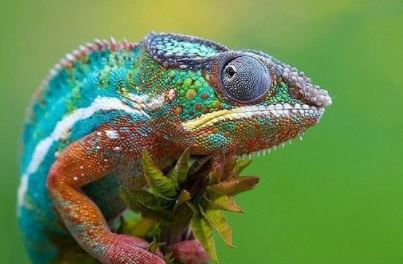What do chameleons need
What do chameleons need: Chameleons are undoubtedly some of the most captivating creatures in the reptile kingdom. With their ability to change colors, independently moving eyes, and long projectile tongues, they possess a unique set of features that have fascinated naturalists and enthusiasts alike for centuries.
These arboreal reptiles are primarily found in tropical and subtropical regions around the world, displaying a remarkable diversity of species. From the flamboyantly colored Panther Chameleon to the cryptic design of Leaf Chameleons, each species showcases its own charm and peculiarities.
However, while chameleons possess an undeniable allure, they also have distinct needs that must be catered to ensure their optimal well-being in captivity. Understanding these specific requirements is paramount for providing suitable care.
It is crucial to create an environment that closely mimics their natural habitat to promote physical and mental health. The importance of comprehending a chameleon’s needs cannot be overstated.
Failure to meet their requirements can lead to stress, illness, and even premature death. Therefore, as responsible keepers or potential owners of these magnificent creatures, it is essential to educate ourselves about their unique physiology and habits in order to provide them with a safe and enriching environment.
Habitat Requirements
Enclosure Size and Type
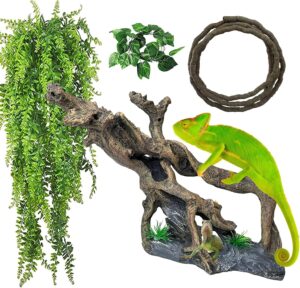 The enclosure for a chameleon is of paramount importance as it serves as their primary habitat. The size and type of enclosure will largely depend on the species of chameleon you plan to keep. It is crucial to provide ample space for their natural behaviors, such as climbing and basking.
The enclosure for a chameleon is of paramount importance as it serves as their primary habitat. The size and type of enclosure will largely depend on the species of chameleon you plan to keep. It is crucial to provide ample space for their natural behaviors, such as climbing and basking.
For small chameleon species, a terrarium with dimensions of at least 18x18x36 inches is typically suitable, while larger species may require enclosures exceeding 24x24x48 inches. A screen cage is often recommended for proper ventilation since it helps maintain airflow within the enclosure.
Temperature and Humidity Control
Maintaining appropriate temperature and humidity levels within the chameleon’s habitat are vital factors in ensuring their health and well-being. Chameleons are ectothermic creatures, meaning they rely on external heat sources to regulate their body temperature. The optimal temperature range varies among different species but generally falls between 75-85°F (24-29°C) during the day, with a slight drop at night.
Recommended Temperature Range for Different Species
Species like Veiled Chameleons (Chamaeleo calyptratus) prefer temperatures around 80-85°F (27-29°C) during the day, while Panther Chameleons (Furcifer pardalis) thrive in temperatures ranging from 75-80°F (24-27°C). Jackson’s Chameleons (Trioceros jacksonii), on the other hand, prefer slightly cooler temperatures ranging from 70-80°F (21-27°C).
Proper Heating and Lighting Setup
To achieve suitable temperatures within the chameleon’s enclosure, it is essential to incorporate proper heating elements such as heat lamps or ceramic heat emitters. These heat sources should be positioned at one end of the enclosure to provide a temperature gradient, allowing the chameleon to choose their preferred level of warmth. Additionally, the use of full-spectrum UVB lighting is crucial as it aids in vitamin D3 synthesis, which is necessary for calcium absorption and overall bone health in chameleons.
Humidity Levels and Methods to Maintain Them
In their natural habitats, chameleons are exposed to relatively high humidity levels due to their arboreal nature. Maintaining humidity within their enclosure is crucial for proper hydration and shedding.
A humidity level between 50-70% should be maintained, with occasional spikes during misting sessions. This can be achieved by misting the enclosure multiple times a day or by incorporating an automatic misting system that simulates rainfall.
The use of live plants also helps maintain humidity levels by facilitating moisture retention through transpiration. By diligently considering these crucial habitat requirements, you can ensure that your chameleon has a comfortable and thriving environment that meets their specific needs.
Substrate and Decorations
Suitable substrate options
When it comes to choosing the right substrate for your chameleon’s enclosure, there are a few options that work well. Coconut fiber, also known as coir, is a popular choice due to its ability to retain moisture without becoming soggy. This substrate mimics the forest floor where chameleons are found in the wild, making it ideal for creating a naturalistic environment.
Another suitable option is sphagnum moss, which not only retains moisture but also helps with humidity regulation within the enclosure. It provides a soft and comfortable surface for your chameleon to explore and rest on.
Incorporating live plants for naturalistic environment
Creating a naturalistic environment in your chameleon’s enclosure is crucial for their overall well-being. Live plants not only enhance the aesthetic appeal of the habitat but also provide numerous benefits for your pet.
Chameleons thrive in habitats with lush vegetation, as it allows them to hide and feel secure while providing opportunities for climbing and basking. Incorporating live plants such as pothos, ficus trees, or hibiscus can greatly enrich their living space.
Chameleon-friendly plant species suggestions
When selecting live plants for your chameleon’s habitat, it’s important to choose species that are safe and non-toxic to them. Pothos (Epipremnum aureum) is an excellent choice as it is hardy, easy to care for, and provides ample coverage with its cascading vines.
Ficus trees (Ficus benjamina) are another suitable option as they offer vertical climbing opportunities while adding a touch of lush greenery. Hibiscus (Hibiscus rosa-sinensis) adds vibrant flowers that not only beautify the enclosure but may also stimulate natural feeding behaviors due to their attractive colors.
Benefits of live plants in maintaining humidity levels
One of the significant advantages of incorporating live plants in a chameleon’s enclosure is their ability to help maintain proper humidity levels. As chameleons originate from tropical regions, they require higher humidity in their environment.
Live plants act as natural humidifiers by transpiring moisture through their leaves, thereby increasing the overall humidity within the enclosure. Not only does this mimic their natural habitat, but it also helps prevent dehydration and respiratory issues that can arise from excessively dry conditions.
Additionally, live plants contribute to air purification by absorbing carbon dioxide and releasing oxygen, creating a healthier living space for your chameleon. By carefully selecting suitable substrates and incorporating live plants in your chameleon’s habitat, you can create an environment that closely mimics their natural home.
This not only provides visual appeal but also offers numerous benefits for your pet’s health and well-being. Remember to research specific plant species thoroughly before introducing them to ensure they are safe for your chameleon’s consumption or contact.
Feeding and Nutrition
Overview of chameleon’s diet in the wild (insects, fruits, flowers)
Chameleons are primarily insectivores in the wild, relying on a diverse range of insects to meet their nutritional needs. Common prey items include crickets, grasshoppers, locusts, flies, and moths.
Additionally, some chameleon species may opportunistically consume small vertebrates such as lizards or birds. While insects form the mainstay of their diet, certain chameleon species may also consume small amounts of fruits and flowers for additional hydration and nutrients.
Captive feeding considerations
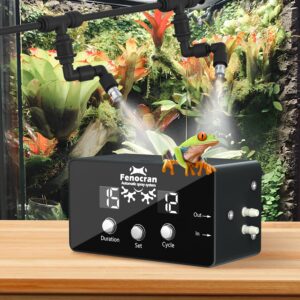 When it comes to feeding chameleons in captivity, replicating their wild diet is crucial for their overall health. However, there are a few important considerations to keep in mind. Firstly, it is essential to select appropriate insect prey that is nutritionally rich and safe for your chameleon.
When it comes to feeding chameleons in captivity, replicating their wild diet is crucial for their overall health. However, there are a few important considerations to keep in mind. Firstly, it is essential to select appropriate insect prey that is nutritionally rich and safe for your chameleon.
Opt for gut-loaded insects that have been fed with high-quality diets before being offered to your reptile friend. This ensures that the insects themselves are packed with essential nutrients.
Appropriate insect selection (gut-loading, dusting with supplements)
Gut-loading refers to the process of feeding nutrient-rich food to the insects before they are fed to chameleons. This ensures that when consumed by the reptile, they provide optimal nutritional value.
Commonly used gut-loading foods include dark leafy greens like kale or collard greens along with vegetables like carrots or squash. Dusting is another important practice where you lightly coat feeder insects with calcium and vitamin D3 supplements just before offering them to your chameleon.
Supplementing with calcium and vitamin D3
To maintain optimum health in captive chameleons, calcium supplementation is crucial as it aids in proper bone development and prevents metabolic bone disease. A calcium powder with added vitamin D3 should be provided in the diet regularly.
Vitamin D3 is essential for calcium absorption, especially in reptiles that have limited exposure to natural sunlight. Adequate UVB lighting also helps chameleons produce their own vitamin D3 when they are exposed to it.
Importance of variety in diet to prevent nutritional deficiencies
Incorporating a varied diet is vital to ensure that chameleons receive a wide range of nutrients and prevent nutritional deficiencies. Offering different types of feeder insects provides varied protein sources and nutrient profiles. Additionally, occasional inclusion of small amounts of fruits and flowers can contribute to hydration and supply additional vitamins and minerals.
However, caution must be exercised as certain fruits may contain high levels of sugar or undesirable compounds, so moderation is key. Remember, understanding the intricacies of feeding and nutrition for your chameleon will help you provide a balanced diet that supports their overall well-being and longevity in captivity.
Watering Methods
Providing access to clean water sources
Chameleons, being arboreal creatures, have specific requirements when it comes to hydration. They do not typically drink water from bowls or other standing sources like many other reptiles. Instead, chameleons prefer to drink droplets of water that collect on leaves or other surfaces after rain or mistings.
Therefore, it is crucial to replicate this natural drinking behavior in their captive environment. To provide access to clean water sources, chameleon keepers often use two main methods: mistings and drippers.
Mistings vs drippers: pros and cons
Mistings involve spraying a fine mist of water inside the chameleon’s enclosure. This method simulates rain and allows the droplets to collect on leaves and surfaces for the chameleon to drink from.
The advantage of misting is that it not only provides hydration but also helps maintain humidity levels within the enclosure. However, there are some considerations with mistings.
First, they may cause excessive moisture if done too frequently or for extended periods, which can lead to respiratory issues or mold growth in the enclosure if not properly managed. Additionally, some chameleons may dislike direct sprays or feel stressed by them.
On the other hand, drippers provide a constant slow drip of water into a designated area within the enclosure. This allows droplets to form on specific leaves or branches where the chameleon can easily access them for drinking purposes.
One of the advantages of drippers is that they offer a more controlled hydration method without directly spraying the chameleon itself, reducing stress for some individuals who might be skittish around sprays. However, ensuring that the dripping system functions properly and does not create excess moisture pooling in one area can be challenging.
Automatic misting systems for convenience
For chameleon keepers who want to guarantee regular mistings without the need for constant manual spraying, automatic misting systems can be a convenient solution. These systems typically consist of programmable timers and nozzles that release a fine mist at specified intervals.
Automatic misting systems ensure consistent hydration and humidity levels throughout the day, mimicking natural rainfall patterns. They also alleviate the need for manual spraying, which can be time-consuming.
However, it is crucial to monitor such systems regularly to ensure they are functioning correctly and not over-misting the enclosure. Regular maintenance, including cleaning of nozzles and tubing to prevent clogging or bacterial growth, is also important for the system’s effectiveness and the chameleon’s well-being.
Providing clean water sources for chameleons involves replicating their natural drinking behavior in captivity. The methods of mistings and drippers offer different advantages and considerations.
Automatic misting systems can provide convenience but require proper monitoring and maintenance to avoid potential issues. Understanding these watering methods is vital in ensuring that chameleons receive adequate hydration while maintaining optimal humidity levels in their enclosures.
Environmental Enrichment
Branches, Vines, and Perches for Climbing Opportunities
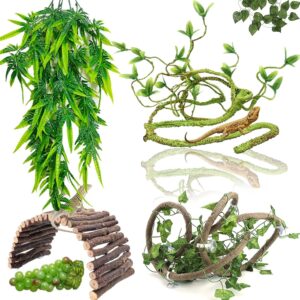 Chameleons are natural climbers and providing them with a stimulating environment that mimics their natural habitat is crucial for their physical and psychological well-being. One of the key elements of environmental enrichment is the inclusion of branches, vines, and perches within their enclosure. These structures not only serve as climbing opportunities but also provide exercise, help maintain muscle tone, and promote natural behaviors such as basking and hunting.
Chameleons are natural climbers and providing them with a stimulating environment that mimics their natural habitat is crucial for their physical and psychological well-being. One of the key elements of environmental enrichment is the inclusion of branches, vines, and perches within their enclosure. These structures not only serve as climbing opportunities but also provide exercise, help maintain muscle tone, and promote natural behaviors such as basking and hunting.
When selecting branches, it is important to choose sturdy ones that can support the weight of your chameleon. Opt for non-toxic tree branches like ficus or hibiscus, ensuring they are appropriately sized to allow your chameleon to move comfortably.
Secure the branches securely in the enclosure so that they can support your chameleon’s weight without any risk of falling or collapsing. Vines can be added to create a more dynamic environment for your chameleon.
They allow for increased mobility and provide extra hiding spots if draped over branches or secured to the sides of the enclosure. Additionally, faux vines made from non-toxic materials can be used for aesthetic purposes while offering additional climbing opportunities.
Introduction to Hiding Spots or Shelters
Providing hiding spots or shelters is essential as it allows chameleons to retreat when they feel threatened or stressed. These shelters simulate the feeling of security found in nature by creating secluded areas where they can feel hidden from potential predators or excessive stimuli.
Naturalistic hides such as plant pots turned on their sides with an opening cut into them can work effectively. It’s important to position these hiding spots strategically throughout the enclosure so that there are options available at different heights.
Chameleons may prefer higher hideouts during certain times while choosing lower ones during others. This variability allows them to regulate their body temperature and choose a hiding spot that aligns with their comfort level.
While it is essential to provide hiding spots, ensure that they don’t obstruct the chameleon’s access to necessary resources like food, water, or basking areas. Strike a balance between creating an enriched environment and maintaining functionality within the enclosure.
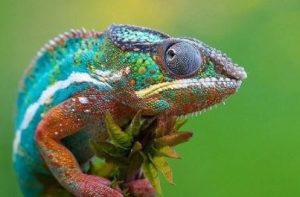
Ideal Positioning within the Enclosure
When incorporating branches, vines, perches, and hiding spots within the chameleon’s enclosure, proper positioning is crucial. Aim for a layout that maximizes usable space while providing a variety of options for your chameleon to explore. Place branches in different orientations and heights throughout the enclosure to create multiple climbing routes.
This will encourage exercise and exploration while also simulating their natural habitat. Consider using suction cup mounts or brackets to secure branches on the sides of the terrarium for vertical climbing opportunities.
When arranging hiding spots or shelters, position them near heat sources such as basking lamps or heating elements while ensuring they are easily accessible from climbing structures. This arrangement allows your chameleon to feel secure while still benefiting from appropriate temperatures required for digestion and overall well-being.
Remember that chameleons are arboreal creatures; therefore, prioritize creating an enriched vertical environment with ample opportunities for climbing and exploration. By providing well-positioned branches and accessories in their enclosures, you can offer your chameleons an engaging habitat that meets their instinctual needs while promoting physical activity and mental stimulation.
Behavioral Stimulation
Explore the Importance of Simulating Natural Behaviors
Chameleons are fascinating creatures that exhibit a wide range of natural behaviors in their native habitats. As responsible chameleon owners, it is crucial to provide them with opportunities to engage in these behaviors even within the confines of a captive environment. By simulating their natural behaviors, we not only ensure their physical well-being but also promote psychological enrichment.
One important aspect of behavioral stimulation is providing ample climbing opportunities. Chameleons are arboreal creatures and spend a significant portion of their time climbing trees and branches in the wild.
Mimicking this vertical habitat by adding sturdy branches, vines, and perches in their enclosure allows chameleons to exercise, explore their territory, and feel secure as they would in their natural environment. Moreover, introducing hiding spots or shelters is essential for chameleons to retreat when they feel stressed or need privacy.
These sheltered areas could be created using plants or artificial structures placed strategically within the enclosure. Providing hiding spots helps reduce anxiety levels and allows chameleons to regulate their body temperature while feeling safe.
Introduction to UVB Lighting
UVB lighting is a crucial component when it comes to meeting the behavioral needs of chameleons. In the wild, these reptiles bask under sunlight that contains ultraviolet B (UVB) rays which aid in vitamin D production and calcium absorption.
Therefore, replicating this natural sunlight exposure through artificial UVB lighting sources becomes imperative for healthy captive chameleons. UVB light helps stimulate essential behaviors such as feeding, reproduction, activity levels, and overall well-being.
It plays a vital role in maintaining proper bone growth and metabolism by allowing chameleons to utilize dietary calcium effectively. Without sufficient UVB exposure, they may develop health issues like metabolic bone disease, resulting in weakened bones and other complications.
When setting up UVB lighting for chameleons, it is essential to select high-quality bulbs specifically designed for reptiles. The correct placement and intensity of the light source need to be considered to ensure chameleons receive the appropriate UVB exposure without being directly exposed to ultraviolet A (UVA) or excessive heat.
To sum up what do chameleons need
Meeting the behavioral needs of chameleons is crucial for their overall health and well-being. By simulating natural behaviors through climbing opportunities and providing hiding spots, we give them a sense of security and allow them to exhibit their natural instincts.
Additionally, adequate UVB lighting enables proper physiological functions such as calcium absorption and vitamin D synthesis. As responsible chameleon owners, it is our duty to provide an enriched environment that caters to their behavioral needs.
By creating a habitat that encourages natural behaviors and ensuring they have access to appropriate lighting, we can enhance their quality of life significantly. Remember, by replicating their natural habitat as closely as possible, we not only promote physical health but also contribute to their mental stimulation and happiness.
Further Reading:

